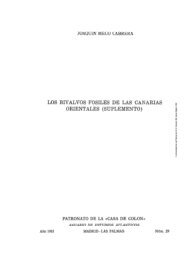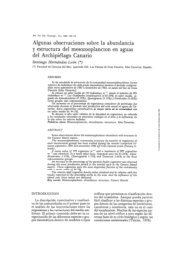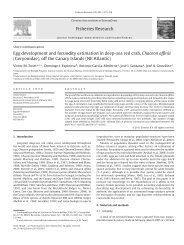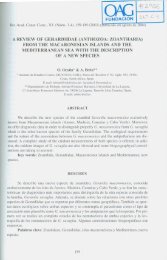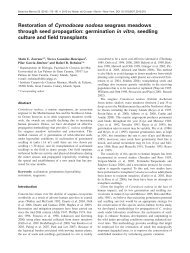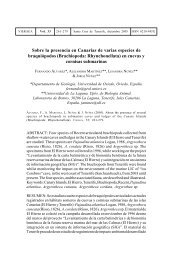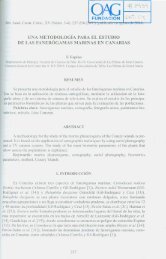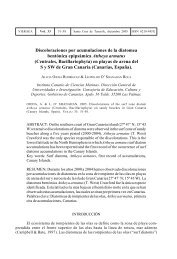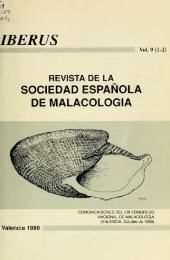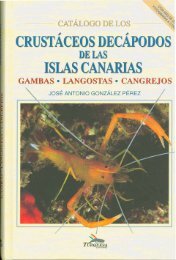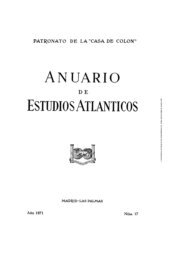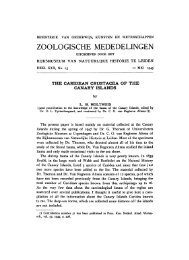of the madeira and selvagens archipelagos - redmic
of the madeira and selvagens archipelagos - redmic
of the madeira and selvagens archipelagos - redmic
You also want an ePaper? Increase the reach of your titles
YUMPU automatically turns print PDFs into web optimized ePapers that Google loves.
caronésia, onde ocorre uma gr<strong>and</strong>e diversidade de briófitos<br />
que cobrem densamente os troncos, os ramos das árvores<br />
e arbustos (Fontinha et al. 2006; Kürschner et al. 2007a).<br />
Também se podem destacar outros ecossistemas, quer no<br />
maciço montanhoso no centro da ilha, quer nas zonas costeiras,<br />
igualmente com gr<strong>and</strong>e diversidade e abundância de<br />
espécies, embora integr<strong>and</strong>o comunidades distintas (Capelo<br />
et al. 2000; Kürschner et al. 2007a, b). Apesar da bri<strong>of</strong>lora<br />
nas zonas secas costeiras (Sérgio & Fontinha 1994; Fontinha<br />
1995; Fontinha & Sérgio 1998) ser menos abundante e<br />
diversa, é constituída por taxa únicos endémicos e por muitas<br />
espécies com afinidades com a Região Mediterrânica.<br />
A cobertura da vegetação nativa da ilha da Madeira e<br />
Selvagens s<strong>of</strong>reu gr<strong>and</strong>es perturbações após a descoberta<br />
das ilhas pelos navegadores portugueses do século XV. Estes<br />
acontecimentos, relativamente recentes, possibilitaram<br />
a avaliação do estatuto de conservação da flora de briófitos<br />
na Madeira e Selvagens, com base nas espécies endémicas,<br />
extintas ou ameaçadas na Europa (Sérgio et al. 1992).<br />
Dada a sua posição geográfica, a Madeira e as Selvagens<br />
apresentam uma bri<strong>of</strong>lora particular, resultante do ponto de<br />
encontro de taxa com a sua distribuição principal no Mediterrâneo,<br />
nas zonas temperadas da Europa, na América, do<br />
Norte e do Sul, e em África. A ilha da Madeira abriga indubitavelmente<br />
paleo -endemismos (Tavares 1965; Sérgio 1984).<br />
No entanto, deve -se ter em conta que a definição de endemismo<br />
depende do conhecimento da distribuição mundial<br />
actual e passada, do grupo taxonómico em questão e dos<br />
novos estudos que vão sendo desenvolvidos em áreas bioclimáticas<br />
semelhantes ou em áreas com afinidades geográficas<br />
(Sim -Sim et al. 2004, 2005 a,b; Stech et al. 2006, 2007).<br />
2. Estado do conhecimento<br />
Os primeiros trabalhos de investigação e as primeiras<br />
colecções de briófitos datam do final do século XVIII (Forster<br />
1787) e início do século XIX (Bowdich 1825), mas foi na<br />
primeira metade do século XX, com Luisier (1907a, 1956,<br />
in Sérgio et al. 2006), que a bri<strong>of</strong>lora começou a ser mais<br />
bem estudada. Durante esse período são de destacar os<br />
trabalhos realizados por Persson e Luisier, os investigadores<br />
que mais contribuíram para a briologia na Madeira.<br />
Também são de realçar as prospecções e publicações realizadas<br />
por Hübschmann (1971), Sjögren (1975) e Koppe<br />
& Düll (1986). Nas últimas duas décadas a ilha da Madeira<br />
tem sido estudada intensivamente, muitas publicações têm<br />
sido produzidas, assim como têm surgido boas colecções<br />
de herbário, desenvolvidas por M. Nóbrega (MADS – Museu<br />
de História Natural do Seminário do Funchal, MADJ<br />
– Jardim Botânico da Madeira) e por C. Sérgio (LISU – Museu<br />
Nacional de História Natural, Jardim Botânico, Lisboa).<br />
Actualmente, sobretudo a partir do primeiro apoio da WWF<br />
(implementado por C. Sérgio em 1990 a 1993), um trabalho<br />
contínuo tem vindo a ser desenvolvido por outros briologistas,<br />
nomeadamente M. Sim -Sim (desde 1982), S. Fontinha<br />
(desde 1990), L. Hedenäs (desde 1992), W. Frey e M. Steck<br />
(desde 2002) e, mais recentemente, por H. Kürschner.<br />
125<br />
Fontinha & Sérgio 1998) is poorer in number <strong>of</strong> species <strong>and</strong><br />
diversity, it comprises unique endemic taxa, <strong>and</strong> many species<br />
with Mediterranean affinities.<br />
Compared to o<strong>the</strong>r parts <strong>of</strong> <strong>the</strong> world, especially Europe,<br />
<strong>the</strong> native plant cover <strong>of</strong> Madeira Isl<strong>and</strong> suffered a relatively<br />
recent disturbance, just after <strong>the</strong> <strong>of</strong>ficial Portuguese discovery<br />
<strong>of</strong> <strong>the</strong>se isl<strong>and</strong>s back in <strong>the</strong> 15th century. This fact <strong>of</strong>fered<br />
researchers <strong>the</strong> chance for <strong>the</strong> first time to evaluate <strong>the</strong><br />
status <strong>of</strong> <strong>the</strong> bryophyte flora with reference to endemic <strong>and</strong><br />
extinct or threatened European species (Sérgio et al. 1992).<br />
Due to <strong>the</strong> geographical position <strong>of</strong> <strong>the</strong> archipelago, Madeira<br />
Bry<strong>of</strong>lora is unique, as it includes taxa that have <strong>the</strong>ir<br />
main distribution areas in <strong>the</strong> Mediterranean, in <strong>the</strong> temperate<br />
regions <strong>of</strong> Europe, North <strong>and</strong> South America <strong>and</strong> Africa.<br />
Taking into consideration <strong>the</strong> wide distribution <strong>of</strong> many<br />
bryophyte species, Madeira Isl<strong>and</strong> has without a doubt an<br />
important number <strong>of</strong> palaeo -endemic taxa (Tavares 1965;<br />
Sérgio 1984). Notwithst<strong>and</strong>ing, <strong>the</strong> existence <strong>of</strong> endemic<br />
species is always dependent on <strong>the</strong> global distribution, present<br />
<strong>and</strong> past, <strong>of</strong> <strong>the</strong> taxonomic group to which <strong>the</strong>y belong<br />
as well as <strong>the</strong> new research on bioclimatically related areas<br />
or areas with geographical affinities (Sim -Sim et al. 2004,<br />
2005 a,b; Stech et al. 2006, 2007).<br />
2. Current knowledge<br />
Major botanical research <strong>and</strong> preparation <strong>of</strong> bryological<br />
collections began in <strong>the</strong> late 18th century (Forster 1787)<br />
<strong>and</strong> early 19th century (Bowdich 1825). Never<strong>the</strong>less, <strong>the</strong><br />
Bry<strong>of</strong>lora seems to have been better studied in <strong>the</strong> first<br />
part <strong>of</strong> <strong>the</strong> 20th century by Luisier (1907 a 1956, in Sérgio<br />
et al. 2006). For that period we highlight <strong>the</strong> works<br />
by Persson <strong>and</strong> Luisier, as <strong>the</strong>y were in fact <strong>the</strong> promoters<br />
<strong>of</strong> bryology in Madeira. Equally important are surveys<br />
<strong>and</strong> publications by Hübschmann (1971), Sjögren (1975)<br />
<strong>and</strong> Koppe & Düll (1986). In <strong>the</strong> last two decades, Madeira<br />
Isl<strong>and</strong> was intensively researched <strong>and</strong> documented, with<br />
good herbaria collections by M. Nóbrega (MADS – Museu<br />
de História Natural do Seminário do Funchal, MADJ<br />
– Jardim Botânico da Madeira) <strong>and</strong> by C. Sérgio (LISU<br />
– Museu Nacional de História Natural, Jardim Botânico,<br />
Lisboa). In <strong>the</strong> course <strong>of</strong> studies supported by <strong>the</strong> WWF<br />
(implemented by C. Sérgio in 1990 -1993), ongoing work<br />
is being done by o<strong>the</strong>r bryologists such as M. Sim -Sim<br />
(since 1982), S. Fontinha (since 1990), L. Hedenäs (since<br />
1992), W. Frey <strong>and</strong> M. Steck (since 2002) <strong>and</strong> more recently<br />
by H. Kürschner.<br />
The bryophyte diversity <strong>of</strong> <strong>the</strong> laurel forest, <strong>the</strong> ecology <strong>of</strong><br />
<strong>the</strong> bryophytes <strong>and</strong> <strong>the</strong>ir biogeographical relationship to <strong>the</strong>



